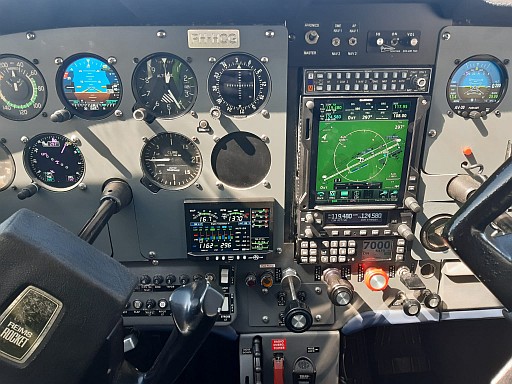Cessna FR 172 J Reims Rocket
The Cessna 172 is a well-known aircraft, but if you have never heard of it, please read on.

The main differences with a 'normal' Cessna 172 are the robust 210 hp 6-cylinder Continental engine and the constant speed propeller. This is 50 or 60 hp more compared to the usual 4-cylinder Lycoming engines that you find on normal 172s. The constant speed propeller also provides the most efficient propeller speed in every phase of flight. A characteristic of this is the 'kick-in-the-back' during takeoff.

The aircraft was completely stripped and given a modern color scheme in 2011. The original wheelfairings are also present, which you often don't see anymore.

In this photo, you can still see the Gemolzig Silencer that has been removed in 2023 because of the STC for the MT-propeller. The noise category remains the same due to the lower noise levels of the 3-bladed propeller.

Equipped since 2022 with a modern 3-blade scimitar propeller. This makes the aircraft quieter and also has a larger ground clearance.
The cockpit

Modern glass cockpit. Fully equipped for IFR and installed in 2022. I still only use it for VFR, but the plane has been used for IFR training.
The old vacuum system has been removed. There is only one old gyro left: the turn coordinator.
All Garmin: Two GI-275s as AI and ADI. They can take over each other's function. As COM1/NAV1 and GPS (WAAS) a supermodern GTN-750 Xi with a large touch screen. As COM2/NAV2 a GNC 255 which can also monitor the standby frequency. So you can listen to three frequencies simultaneously!
Everything required by law for VFR and IFR is present; a mode S transponder, a 406MHz ELT, an ADF, two VORs (both with glideslope for ILS approaches) and even a DME.
Perhaps unnecessary, but very nice when flying from the right seat is a complete Primary Flight Display (PFD) present.
A uAvionix AV-30C with battery backup!
Interior

The entire cabin was completely modernized in 2011. The interior looks excellently cared for. Nothing broken, dirty or torn. Comfortable seats with leather upholstery.

The seats for the passengers are also nice and comfortable.
Engine and airframe
In March 2010, the engine was completely overhauled by Loma from Belgium. Everything was renewed (even the crankcase), so there is actually a new engine in it. The airframe was also overhauled. All ADs and SBs have been processed and there is no item 'on condition'. Maintenance via CAMO.
Performance and fuel consumption
Thanks to the strong engine, this plane is quickly airborne and climbs like a rocket. If you use full power, it stands out quite a bit for people present at the airport. This is probably due to a combination of a relatively high RPM (2800) at a relatively fine pitch. By reducing the propeller speed early to 2500 RPM, you can limit the noise considerably without it really affecting the take-off performance. Reducing to 2500 RPM is already part of the after-takeoff checklist.
The 6-cylinder Continental is of the injection type (IO-360) and has a total capacity of 5.9 liters (almost 1000 cc per cylinder). The consumption is on average around 36 liters of AvGas per hour, but of course, it strongly depends on the power settings and cruising altitude. I usually cruise between 1000 and 3000 feet and with 23 inches of manifold pressure while leaning to a consumption of 8 to 9 gallons per hour. When I make a longer trip, I often try to cruise between 6,000 and 10,000 feet, which reduces your consumption and increases your speed. Above 8,000 feet, I achieve a TAS of 125kts with a consumption of about 30 liters per hour. At lower altitudes, that is only possible with full-power cruising, but the consumption then goes towards 45 liters per hour.
For more information or to schedule a viewing, contact Hans van de Ven.
Reachable via email or phone 06-1979 2107
